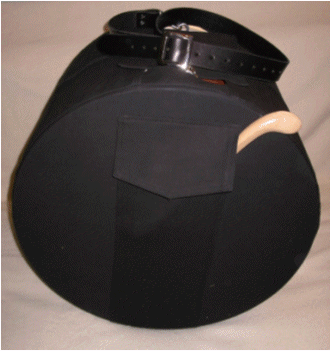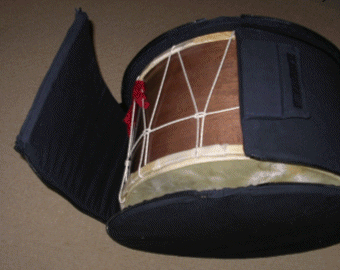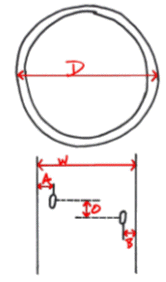Besides making drums I also make cases and straps. All the cases I make have double fabric faces on both sides enclosing circles of ¼" plywood to protect the heads and a pocket on one face for sticks (illustrated here by one of my heavy sticks) and other ephemera. I make two versions: standard, which has single-layer fabric on the edge and a single zipper, and heavy duty, which has closed cell foam padding enclosed in 2 layers of fabric and two zippers, one at the edge of each face. Both designs have openings that let the drum strap come out so the drum in the case can be carried the same way as the drum without the case. No matter which kind you want, I need either the drum itself, or accurate dimensions if you want the case to fit.
Cases can be made in any color, the default being black, but I've made red, red and black and navy blue. I recommend staying away from light colors because they show dirt more and there is no easy way to clean the cases. I usually use heavy cotton duck, but other materials are available (ripstop nylon, kevlar, etc.) at additional cost.
For most people, the standard case is the way to go. It is easier to use and more convenient. But if you are doing a lot of traveling to gigs, particularly if airlines are involved, you probably need the heavy duty one. I'm sure the airlines can still damage a drum in the heavy duty case (just the high altitude dryness is a major problem) but at least it makes it more of a challenge.
I sometimes get asked by people purchasing drums why cases are cheaper if they buy them with a drum rather than buying them later. The reason is quite simple. I don't want to see that new drum back in 3 months for a new head. It's worth it to me to give you a price break to protect my work.
[Parenthetical drum anecdote: There is a drum of mine out there with a very neat red wine circle on the light head. The owner put it aside at a party, looked back and someone had put a wine glass on it, mistaking it for a coffee table. No harm done, but it will never come out. Drum heads are made by the same processes that makes the vellum used in Medieval manuscripts, and thus they take stains really well.]
Straps

I usually make tupan straps out of 1 ½" black leather strap. If you'd like another color, like brown, I can do that. I put universal joint clips on the ends and a heavy duty buckle in the middle. Straps adjust between 33" and 46", which should be enough for anybody, but I can make them longer if you play for the NBA or throw the hammer.

Standard
The standard case has a single-layer layer of cloth on the sides. There are zippers centered on both halves of the sides that pull towards the top. The drum strap comes up through an opening at the top of the sides. A flap with velcro edges fits between the strap attachments to close the top. The case is designed to be easily put on after you are done playing so that the heads are immediately protected. Since I rehead drums, I've heard a lot of tales of how heads get damaged. A surprisingly large number were either speared by something on stage (or at a party) when they had been put aside, or swung into something while they were in transit during a gig. Best protection is to always put your drum down in the case and pull the sides up. No need to zip fully until you are leaving as the cases cling fairly well.
Heavy Duty

The heavy duty case has ½" closed cell foam sandwiched between two layers of cloth on the sides. It has two zippers: each goes around one face. It considerably more awkward to use than the standard case, but it does protect the sides of the shell from impact. It is also more expensive than the standard case because it's a lot more work to make.
Dimensions

If you are ordering a case and I don't have the drum, I need the following information:
D = diameter, including the rim, at the widest point. Most drum shells are not cylinders, so measure several different diameters on both faces and send me the largest value.
W = width of the shell (front to back). Sometimes the faces are not parallel. If so, send me the widest width.
A = distance from the left hand face to the center of the left side hardware for attaching the shoulder strap.
B = distance from the right hand face to the center of the right side hardware for attaching the shoulder strap.
[If your shoulder strap clips directly into the ropes, A and B should be how far in from the edge you usually hook.]
O = offset between the two strap attachment points. This is often zero, but I need to know it to get the flap right.
